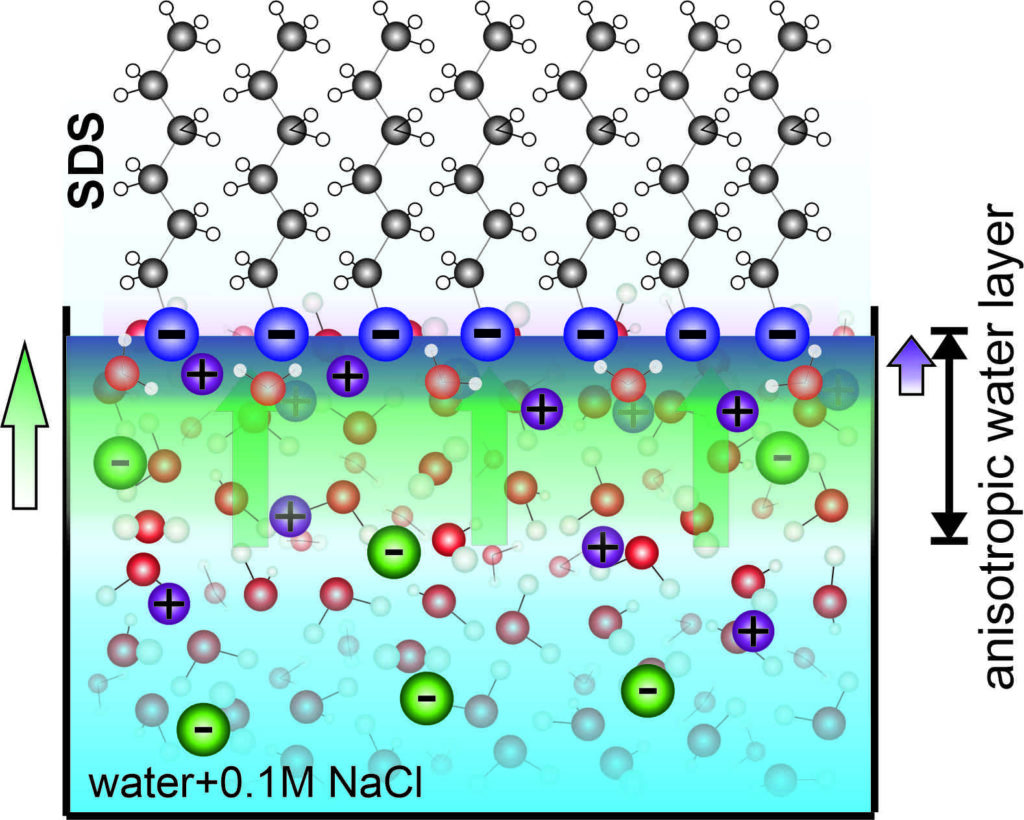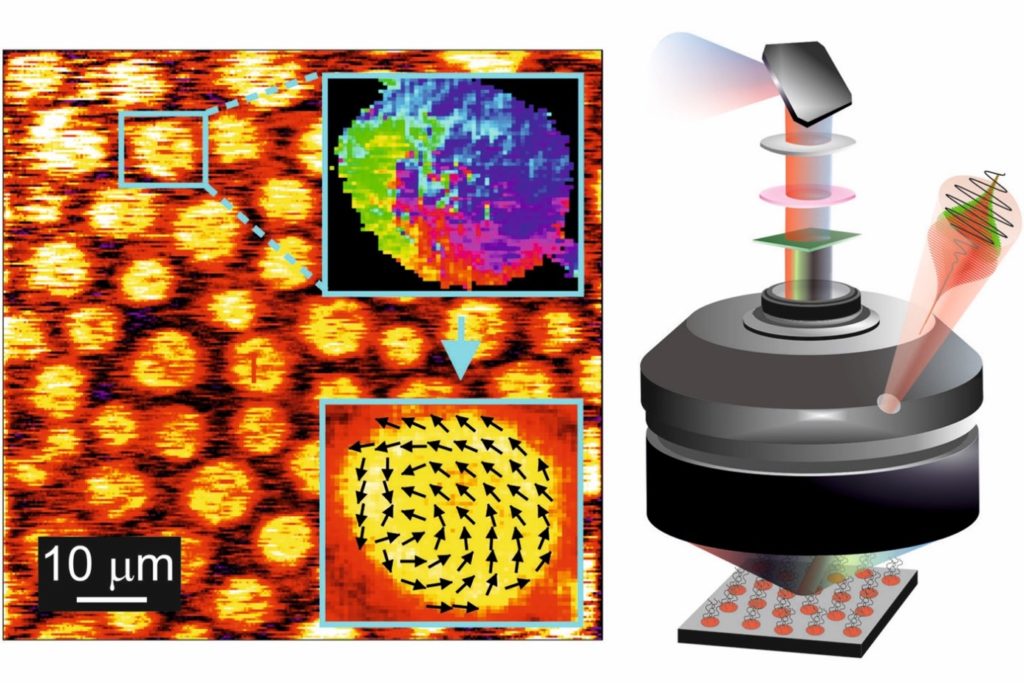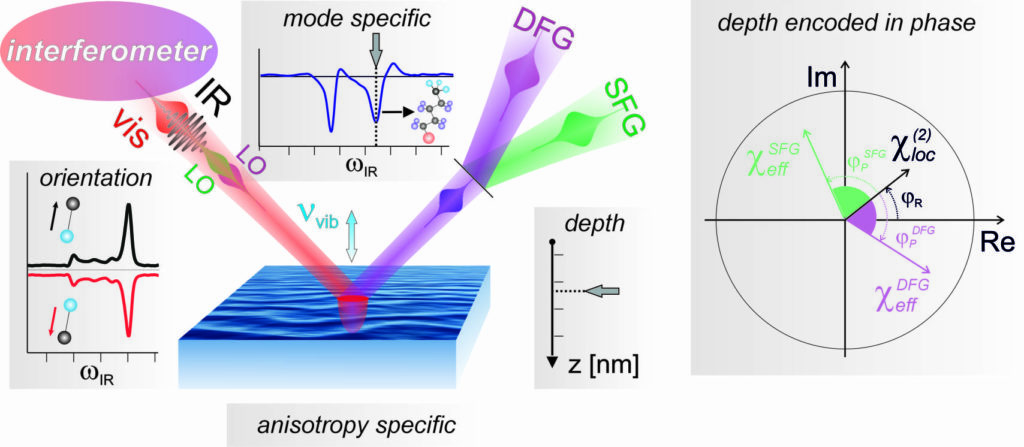General
Numerous crucial chemical processes in biology, environmental chemistry, electrochemistry and heterogeneous catalysis happen exclusively at interfaces. This selectivity originates from the very special physical properties of molecular systems in proximity of a phase boundary which leads to the formation of a great variety of distinct molecular structures and dictates their dynamics. The goal of our research is to gain deeper insight into the fundamental processes that govern interface chemistry and improve our understanding of the underlying physics.
To investigate and ultimately understand interfacial processes, specialized experimental tools are needed that allow for identifying interfacial molecular species, study their structures and follow their dynamics. We therefore develop, refine and employ modern surface spectroscopic techniques based on nonlinear light-matter interactions for the investigation of various molecular interfaces. One special focus of these developments is to combine nonlinear vibrational information with spatial resolution.
Projects
1) Understanding the structural anisotropy at liquid interfaces

When we talk about interfaces, we often imagine a well-defined, thin interface layer that separates the two adjoining bulk phases. In many cases, however, this simple picture is far from being accurate e.g. for liquid interfaces. The presence of a phase boundary can here lead to the formation of an extended region of structural anisotropy where the local physical properties of the liquid clearly deviate from the properties of the corresponding bulk. These deviations are typically caused by gradients along the surface normal in (i) chemical composition of the liquid (e.g. Ion populations), (ii) structural motifs and molecular orientations, and (iii) gradients in the electric potential.
Our goal is to reveal the physical nature of these anisotropic regions and to understand how their properties influence interface chemistry. We therefore investigate the structural depth profiles at various liquid interfaces by performing depth-resolved vibrational spectroscopy.
2) Understanding heterogeneous packing structures in molecular assemblies

When molecules self-assemble at an interface, they can form spatially very heterogeneous molecular structures that vary in molecular composition, orientation, and order. Examples are assemblies of phospholipids in biological membranes. We are interested in revealing the structural details of such heterogeneous assemblies and in understanding the physico-chemical principles underlying the formation of specific structural motifs. Of particular interest are the connections between molecular and structural chirality which we investigate by nonlinear vibrational imaging.
Instrumentation
1) Depth-resolved vibrational spectroscopy
A key technique in our work is depth-resolved vibrational spectroscopy. We pioneered this Laser-based nonlinear technique which exploits the complementary nature of different nonlinear light-matter interaction pathways to obtain depth information with sub-nm precision. This can be achieved e.g. by the combined, phase-sensitive measurement of Sum- and Difference-Frequency-Generation (SFG/DFG) signals where the depth information is encoded in the phase difference between the obtained spectra.

Second order vibrational spectroscopy (such as SFG and DFG) is in many cases interface specific by exclusively probing sample regions with structural anisotropy. Our technique can therefore be used as an ultrafast probe of the vibrational fingerprint of interfacial molecular species, the determination of absolute molecular orientations, and it allows for the elucidation of anisotropic structural depth profiles (e.g. at liquid interfaces).
The accurate measurement of the phase of nonlinear signals that is required in such experiments is a very challenging experimental task and common spectroscopic approaches often lack the required reliability. We have therefore developed a novel spectrometer design that circumvents most of the typical technical deficiencies and allows us to routinely measure accurate phase-resolved second order spectra from various interfaces.
2) Phase sensitive SFG microscopy
Within the project of investigating spatial phenomena at interfaces we recently added vibrational imaging capabilities to our nonlinear vibrational spectroscopy to also resolve lateral sample inhomogeneities. Common SFG microscopes typically suffer from two deficiencies: The first concerns the required tilted sample irradiation which makes the correct imaging highly non-trivial, and the second challenge is the general low signal to noise ratio (S/N) resulting from the weak nonlinear signals.

We have developed a new SFG microscope design that addresses both challenges by employing a new imaging geometry in combination with a paired-pixel balanced imaging scheme. The successful implementation of this phase-sensitive microscope gives us the capability to perform vibrational microscopy experiments on various interesting systems such as biological samples or chiral surfaces with monolayer sensitivity.
3) Development of new spectroscopic tools
We are continuously extending our experimental capabilities with the goal to obtain a maximum of spectroscopic and microscopic information from interfacial systems. These development projects include time resolved techniques such as pump-probe and multidimensional spectroscopies as well as the implementation multimodal nonlinear microscopies.